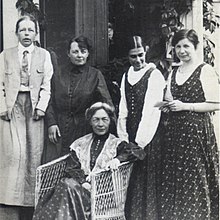Ada Nilsson
Ada Nilsson | |
|---|---|
 | |
| Born | September 21, 1872 |
| Died | May 23, 1964 |
| Nationality | Swedish |
Ada Konstantia Nilsson(September 21, 1872 – May 23, 1964) was an earlySwedishwoman medical doctor. She was one of the founders of the campaigning magazineTidevarvetin 1923.
Early life and education
[edit]Nilsson was born inSödra Sämsin 1872. She was brought up in a farmhouse. Her father, who helped to run the textile workers cottage industry, died when she was thirteen and she went to live in Stockholm.[1]In 1891 she was one of the first women to take medical training, initially in Uppsala and mainly in Stockholm. She metLydia WahlströmandAlma Sundquistwho were also female pioneers.[1]
Career
[edit]
Nilsson andJulia Kinberg,another physician, founded a feminist organization, Frisinnade Kvinnor, in 1914.[2]She was a member of the Liberal Women's National Association.[3]
The magazineTidevarvetwas founded in 1923[4][5]byKerstin Hesselgren,educatorHonorine Hermelin,Ada Nilsson,Elisabeth Tamm,a liberal politician, andElin Wägner,an author.[6][7]The founders had aliberalpolitical stance[7]and were known as the Fogelstad group. Nilsson was one of the principal funders of the project and became editor-in-chief with her new friendElin Wägneras its first editor. The magazine was to publish until 1936 and for three years (1925-28) the magazine ran a free consultancy but it was difficult to fund.[1]
Nilsson metAleksandra Kollontaj,a Russian diplomat and later ambassador to Sweden in the early 1930s. Nilsson cared for Kollontaj when her health started to decline and their correspondence is extant.[8]
Death and private life
[edit]Nilsson had a very close relationship with Honorine Hermelin. During the last year of her life Nilsson went to stay atFogelstadwith Hermelin.[9]Nilsson died inJulita.She was near blind and poor. She was buried in a cemetery near her birthplace.[1]Her life is one of those celebrated in Stockholm'sÖstermalmstorg metro stationbySiri Derkert.[1]
References
[edit]- ^abcde"skbl.se - Ada Konstantia Nilsson".skbl.se.Retrieved1 October2019.
- ^Merle Weßel (2018).An Unholy Union?: Eugenic Feminism in the Nordic Countries, ca. 1890-1940(PhD thesis).University of Helsinki.pp. 37–38.hdl:10138/233107.
- ^Karl Erik Gustafsson; Per Rydén (2010).A History of the Press in Sweden(PDF).Gothenburg: Nordicom.ISBN978-91-86523-08-4.Archived fromthe original(PDF)on 13 February 2015.
- ^"Tidevarvet 1923".Göteborgs Universitetsbibliotek.Retrieved1 October2019.
- ^"Tidevarvet cover page"(PDF).Tidevarvet.24 November 1923.Retrieved1 October2019.
- ^Lene Buchert."Hesselgren, Kerstin (1872-1964)".Performance Magazine.Retrieved30 December2016.
- ^ab"Tidevarvsgruppen (The Age Group), Fogelstad-gruppen (The Fogelstad Group) and the newspaper Tidevarvet (The Age.)".Hjördis Levin's homepage.Archived fromthe originalon 28 August 2007.Retrieved30 December2016.
- ^"skbl.se - Aleksandra Mikhajlova Kollontaj".skbl.se.Retrieved2024-10-13.
- ^"skbl.se - Honorine Louise Hermelin".www.skbl.se.Retrieved28 November2020.
